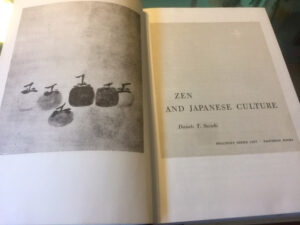 JS picked up this great book in a flea market: Suzuki’s Zen and Japanese Culture. This classic has gone through hundreds of printings in hundreds of languages. I found it an an easy book to value, because it NEVER became pricey in the market since its first printing in 1938.
JS picked up this great book in a flea market: Suzuki’s Zen and Japanese Culture. This classic has gone through hundreds of printings in hundreds of languages. I found it an an easy book to value, because it NEVER became pricey in the market since its first printing in 1938.
JS’s copy came out in 1959. Author, Daisetz Suzuki, writes in his preface, that he begs the reader’s indulgence for not rewriting the book after many years. Instead of rewriting the book he includes three new chapters integral to understanding Zen: Swordsmanship, The Art of Tea, and The Haiku. In the 1959 edition, Suzuki had become, as he says, enamored with the relationship between those topics and Zen. He fit those subjects in a section which includes the Japanese Love of Nature.
Readable for 84 Years
Suzuki illustrated the 1959 edition lavishly with ‘tipped in’ plates; photos of rock gardens, paintings since the 600’s, photos of shrines, and one amazing undocumented painting of the Buddha entering Nirvana. The Buddha sits under the trees, where his mother Queen Maya with medicine, and his disciple Mahakasyapa, both arriving too late. All nature, human and non-human mourns, as the trees burst into flower. This comes from the early 18th century.
This book became an enduring classic mainly because of the way the author uses language to illustrate Zen. A first edition, 1938, will set you back $800. Even the Princeton paperback sells used for $40, because the book remained so readable for 84 years. The language reads befittingly both simple and poetic as it describes 2,500 years of Buddhist history, and relationship to Zen.
Suzuki illustrates concept of Zen with stories
For example this from Goso Hoyen (d 1104):
“If you must ask what Zen is like, I will say it is like learning the art of burglary; The son of an aging burglar asks to learn the art. Thus, the father takes the son on a burglary, and in the night, locks his son into a large trunk, awakens the household, and leaves, unnoticed, to return home. The son lay in the trunk hating his father. He thought to make rat sounds; he was discovered, and fled, hoisting a huge stone into the well in the courtyard. In pursuit, the household flock around the well, looking deep into the dark waters for the drowning burglar. Returning to his father’s house, he accosted his father, who said, ‘Son, don’t be offended, just tell me how you got out of it.’ Which the son did, and then the father said, ‘There you are. You have learned the art.’”
Suzuki comments on this parable: Satori (enlightenment) must be an outgrowth of one’s inner life, and not brought from the outside.
Why use art to illustrate Zen?
Suzuki said, “the artist’s work is of free creation from intuitions directly…unhampered by senses and intellect. He creates forms and sounds out of formlessness and soundlessness.” And then the author makes the case for the uniqueness of Zen because Zen influences every part of life, not only spiritual.
A husband and wife team founded the Bolligen Foundation in 1940. They published books with tremendous impacts on culture, like the 1959 edition of Zen and Japanese Culture. Over many years the Foundation awarded fellowships, and gave an annual prize for poetry. The Foundation published 275 titles, its last one in 2002. Notable individual titles include the Wilhelm/Baynes translation of I Ching or Book of Change, Vladimir Nabokov’s translation of Pushkin’s Eugene Onegin, Erich Neumann’s The Origins and History of Consciousness, Mircea Eliade’s The Myth of the Eternal Return, Isaiah Berlin’s The Origins of Romanticism, Gershom Scholem’s Sabbati Ṣevi, E. H. Gombrich’s Art and Illusion, and Kenneth Clark’s The Nude.
There’s a lovely little delicate beautifully penned inscription from a friend named Shirley on the flyleaf of JS’ book: “To Ann: If your eyes see/ and ears hear/ not a doubt you’ll cherish/ How naturally the rain drips from the leaves!” Throughout the book, Suzuki elegantly analyzes haiku such as this, and here is my favorite, a symphony in simple green after a rainfall: “A solitary frog drenched in rain/Rides on a Basho leaf,/ Unsteadily.”
The value of this flea market treasure is $100.
Pingback: The Zen of Publishing - Elizabeth Appraisals